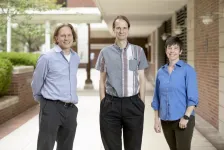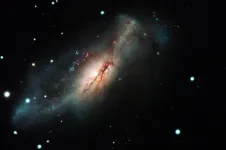(Press-News.org) A gene variant that lowers white blood cell levels and is common in individuals with African ancestry contributes to unnecessary bone marrow biopsies, according to a study published June 28 in JAMA Internal Medicine.
The findings from three institutions, led by investigators at Vanderbilt University Medical Center, provide an example of how using genetic data could reduce a health disparity.
"We've essentially created this racial health disparity by not fully considering how genetic variation affects white blood cell levels," said Jonathan Mosley, MD, PhD, assistant professor of Medicine and Biomedical Informatics at VUMC. "Our study supports genotyping African Americans before performing a bone marrow biopsy for the indication of isolated low white blood cell counts."
It has long been observed that some healthy individuals of African ancestry have lower white blood cell counts -- because of low neutrophil levels -- compared to individuals of European ancestry. The condition, called Benign Ethnic Neutropenia, is associated with a variant in a chemokine receptor gene and does not increase risk for infection. About 63% of African Americans carry two copies of the gene variant that lowers neutrophil levels.
The problem, Mosley explained, is the definition of the "normal" range for white blood cell count, which is based largely on averages from individuals of European ancestry.
"Genetic variation has a large impact on the levels of biomarkers like white blood cell counts, but reference ranges are defined based on population averages without taking genotypes into account," Mosley said.
Mosley, Sara Van Driest, MD, PhD, and Scott Borinstein, MD, PhD, at VUMC set out to determine how the neutrophil-lowering genotype impacted the likelihood of bone marrow biopsies in African American patients.
Working with investigators at Mount Sinai Health System in New York and Children's Hospital of Philadelphia, they examined electronic health records and biobank data to identify African American patients under age 90 who had bone marrow biopsies between 1998 and 2020. At VUMC, the researchers used BioVU, Vanderbilt's DNA biobank linked to de-identified electronic health records.
Among 399 individuals they identified across the three institutions, 35 (9%) had a bone marrow biopsy for the indication of isolated low white blood cell counts, and 97% of these patients (34 of 35) had the neutrophil-lowering genotype compared to 67% of patients who had bone marrow biopsies for other indications. The biopsies were normal for 97% of patients with the neutrophil-lowering genotype (33 of 34) compared to 55% for patients with other histories.
"The genotype that causes lower white blood cells was almost always present in African American individuals who had a bone marrow biopsy solely for a low white blood cell count," said Van Driest, associate professor of Pediatrics and Medicine. "We hope that in the future, we can do a better job of recognizing these individuals with a benign cause for their low white blood cells counts so that bone marrow biopsies can be avoided."
The research team hopes the new study will help educate clinicians about the impact of genetic variation on white blood cell count specifically -- and potentially on many biomarkers.
"It is well established that many healthy African Americans have lower white blood cell counts, and yet these patients are still having biopsies. Clearly, we don't identify Benign Ethnic Neutropenia as frequently as we should," said Borinstein, associate professor of Pediatrics. "Ultimately, we would like to define personalized reference ranges for biomarkers based on genotype. Sometimes there's nothing wrong with having somewhat lower or higher white cell counts, and you don't want to take action on that unless you know there's likely to be disease."
Other biomarkers the researchers are investigating include prostate specific antigen and height in children.
INFORMATION:
VUMC investigators participating in the study also included Lisa Bastarache, MS, Jonathan Schildcrout, PhD, Christian Shaffer, Mingjian Shi, MD, PhD, C. Michael Stein, MD, Dan Roden, MD, and Nancy Cox, PhD. The research was supported by grants from the National Institutes of Health (GM130791, GM131770, HG006830).
Most people associate the term "wearable" with a fitness tracker, smartwatch, or wireless earbuds. But what if you could wear cutting-edge biotechnology in your clothing, and it could warn you when you were exposed to something dangerous?
A team of researchers from the Wyss Institute for Biologically Inspired Engineering at Harvard University and the Massachusetts Institute of Technology has found a way to embed synthetic biology reactions into fabrics, creating wearable biosensors that can be customized to detect pathogens and toxins and alert the wearer.
The team has integrated this technology into standard face masks to detect the presence of the SARS-CoV-2 virus in a patient's breath. The button-activated mask ...
Researchers at Northwestern and George Washington (GW) universities have developed the first-ever transient pacemaker -- a wireless, battery-free, fully implantable pacing device that disappears after it's no longer needed.
The thin, flexible, lightweight device could be used in patients who need temporary pacing after cardiac surgery or while waiting for a permanent pacemaker. All components of the pacemaker are biocompatible and naturally absorb into the body's biofluids over the course of five to seven weeks, without needing surgical extraction.
The device wirelessly harvests energy from an external, remote antenna using near-field ...
A worldwide team led by UC Santa Barbara scientists at Las Cumbres Observatory has discovered the first convincing evidence for a new type of stellar explosion -- an electron-capture supernova. While they have been theorized for 40 years, real-world examples have been elusive. They are thought to arise from the explosions of massive super-asymptotic giant branch (SAGB) stars, for which there has also been scant evidence. The discovery, published in Nature Astronomy, also sheds new light on the thousand-year mystery of the supernova from A.D. 1054 that was visible all over the world in the daytime, before eventually becoming the Crab Nebula.
Historically, supernovae have ...
A worldwide team led by scientists at Las Cumbres Observatory has discovered the first convincing evidence for a new type of stellar explosion -- an electron-capture supernova. While they have been theorized for 40 years, real-world examples have been elusive. They are thought to arise from the explosions of massive super-asymptotic giant branch (SAGB) stars, for which there has also been scant evidence. The discovery also sheds new light on the thousand-year mystery of the supernova from A.D. 1054 that was seen all over the world in the daytime, before eventually becoming the Crab Nebula.
Historically, there have been two main supernova types. One is a thermonuclear supernova -- the explosion of a white dwarf star after it gains matter in a binary star system. These white ...
Engineers at MIT and Harvard University have designed a novel face mask that can diagnose the wearer with Covid-19 within about 90 minutes. The masks are embedded with tiny, disposable sensors that can be fitted into other face masks and could also be adapted to detect other viruses.
The sensors are based on freeze-dried cellular machinery that the research team has previously developed for use in paper diagnostics for viruses such as Ebola and Zika. In a new study, the researchers showed that the sensors could be incorporated into not only face masks but also clothing such as lab coats, potentially offering a new way to ...
All life on Earth 500 million years ago lived in the oceans, but scientists know little about how these animals and algae developed. A newly discovered fossil deposit near Kunming, China, may hold the keys to understanding how these organisms laid the foundations for life on land and at sea today, according to an international team of researchers.
The fossil deposit, called the Haiyan Lagerstätte, contains an exceptionally preserved trove of early vertebrates and other rare, soft-bodied organisms, more than 50% of which are in the larval and juvenile stages of development. Dating to the Cambrian geologic period approximately 518 million years ago and providing researchers with ...
The world of microbes living in the human gut can have far-reaching effects on human health. Multiple diseases, including inflammatory bowel disease (IBD), are tied to the balance of these microbes, suggesting that restoring the right balance could help treat disease. Many probiotics -- living yeasts or bacteria -- that are currently on the market have been optimized through evolution in the context of a healthy gut. However, in order to treat complex diseases such as IBD, a probiotic would need to serve many functions, including an ability to turn off inflammation, reverse damage and restore the gut microbiome. Given all of these needs, researchers from Brigham and Women's Hospital have developed a "designer" ...
A new discovery in rats shows that the brain responds differently in immersive virtual reality environments versus the real world. The finding could help scientists understand how the brain brings together sensory information from different sources to create a cohesive picture of the world around us. It could also pave the way for "virtual reality therapy" for learning and memory-related disorders ranging including ADHD, Autism, Alzheimer's disease, epilepsy and depression.
Mayank Mehta, PhD, is the head of W. M. Keck Center for Neurophysics and a professor in the departments of physics, neurology, and electrical and computer engineering at UCLA. His laboratory studies a brain region called the hippocampus, which is a primary driver of learning and memory, ...
An international team of astronomers has observed the first example of a new type of supernova. The discovery, confirming a prediction made four decades ago, could lead to new insights into the life and death of stars. The work is published June 28 in Nature Astronomy.
"One of the main questions in astronomy is to compare how stars evolve and how they die," said Stefano Valenti, professor of physics and astronomy at the University of California, Davis, and a member of the team that discovered and described supernova 2018zd. "There are many links still missing, so this is very exciting."
There ...
NEW YORK, NY (June 28, 2021)--In the first analysis of its kind, researchers at Columbia University Vagelos College of Physicians and Surgeons and several other institutions have linked distinct patterns of genetic mutations with obsessive-compulsive disorder (OCD) in humans.
The work, published online June 28 in Nature Neuroscience, confirms the validity of targeting specific genes to develop new OCD treatments and points toward novel avenues for studying this often debilitating condition.
OCD, which affects 1% to 2% of the population, often runs in families and genes are known to play a large role in determining who develops the disease. However, the identity of many OCD genes remains unknown.
"Many neurological diseases are ...




